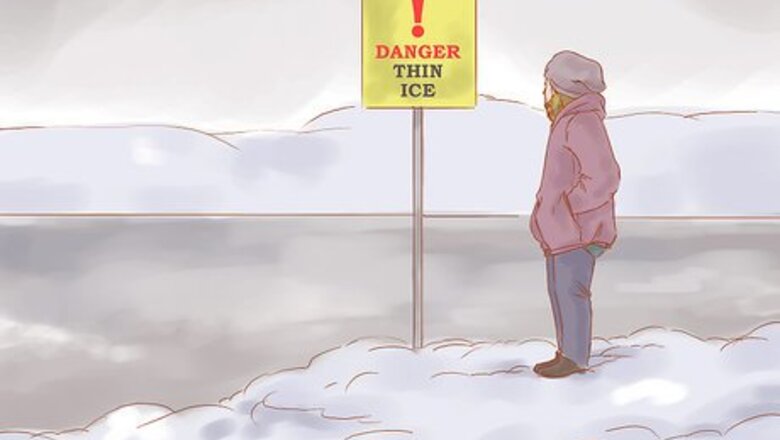
views
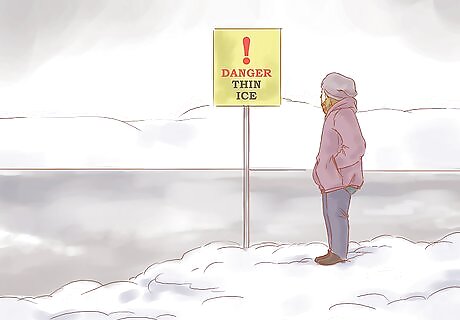
Recognize that ice will never be completely safe. Conditions and unseen or unknown factors can render seemingly safe ice suddenly dangerous. Take all care and precautions to avoid mishaps and to put rescue plans into immediate action should something go wrong.
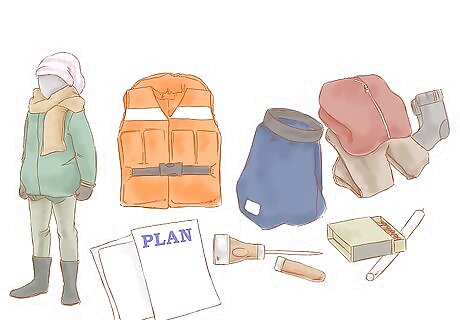
Create an emergency safety plan. Tell people where you are going. If something does go wrong while you are testing or recreating, already have in place the safety procedures that you will carry out for immediate rescue. For starters, you should be adequately dressed in full cold weather attire. Wear some form of flotation device, even a boating life-jacket, especially if you are testing or snowmobiling. Carry an ice-pick which can assist in giving you grip should you fall in. Never go without a buddy or two. Tell other people where you and your buddy are and what time you expect to return home. This is not an occasion for casual spontaneity. Have a spare set of warm dry clothes in a waterproof bag handy. That way you can reduce the risk of hypothermia by changing the wet clothes immediately. Other useful supplies to have as part of an emergency kit include an emergency blanket, hand and foot warmers, thick socks, spare tuques, candles and matches. Pack such emergency items for all winter sports outdoors, even for skating outdoors. See "Things You'll Need" for further information.
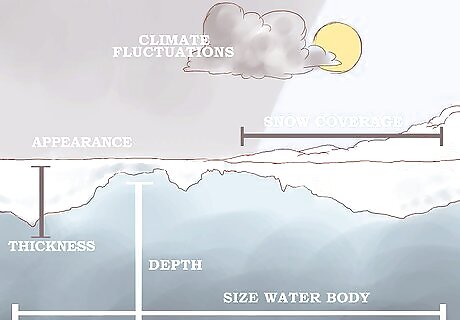
Recognize that determining the safety of ice is dependent on a combination of factors, not on one factor alone. Ice safety is determined by assessing the following factors together: Appearance of the ice - its color, texture and features Thickness of the ice - there are recommended thicknesses for different uses, which are set out below External temperature over a period of time and on the day Snow coverage Depth of water under ice Size of water body Chemical composition of water - whether water is fresh or salt Local climate fluctuations Extent of ice
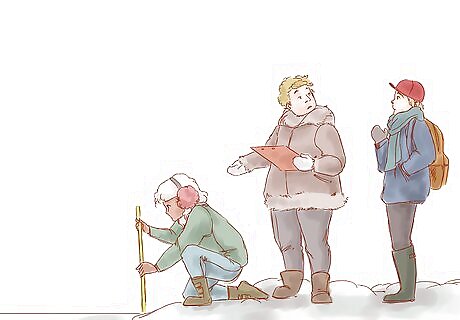
Prefer ice that is checked by designated authorities on a regular basis. Such authorities may be staff at resorts, clubs or national parks or they may be government officials. At a minimum, such checking should occur daily. Ask them about their procedures if you need to know more to satisfy yourself. In the main, they will have access to quality measurement tools and procedures, along with full training in dealing with ice and ice accidents. This will save you the risk of testing and can reassure you. Nevertheless, continue to take all safety precautions.

Ask the locals. If you're from "outta town", don't make any assumptions. Stop at the grocery store, bait shop, local ski store and have a chat, or even drop into a police or fire station and ask questions about the known danger spots and safer spots in the area. People would rather help you out now than have to haul you out later.
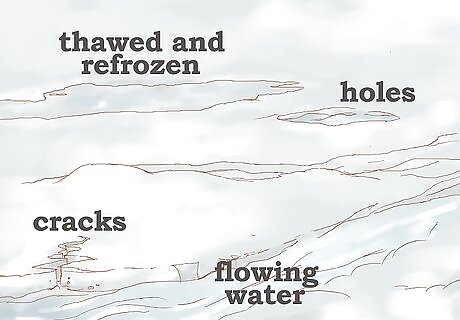
Observe the ice. Look at the ice to see if you can see any cracks, breaks, weak spots or abnormal surfaces and to identify the color(s) of the ice. You cannot rely on your eyesight alone. This is just an initial look to help you to decide if it is even worth proceeding to the next step of testing the ice. If you see any of these signs, you may wish to abandon any further attempt to go on the ice: Flowing water near or at the edges of the ice Flowing springs under the ice in spring fed ponds and lakes. Water flows in and/or out of the iced-over water body Cracks, breaks or holes Ice that appears to have thawed and refrozen Abnormal surfaces that you have not seen before - e.g., pressure ridges caused by currents or winds Remember this ditty: "Thick and blue, tried and true; Thin and crispy, way too risky."
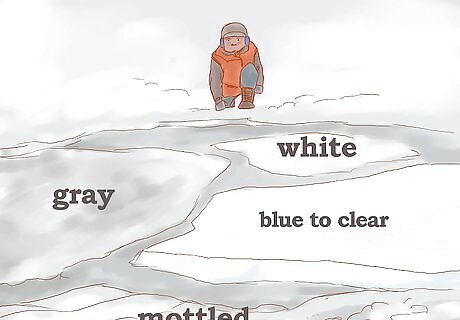
Know your ice color meanings. Although a useful indicator, color alone should not be relied upon. For instance, ice of any color subjected to a running water force underneath will be weaker than ice not subject to that pressure. In general, you can surmise the following from ice colors: Light gray to dark black - Melting ice, occurs even if air temperature is below 32°F (0°C). Not safe, its weak density can’t hold a load, stay off. White to Opaque - Water-saturated snow freezes on top of ice forming another thin ice layer. Most times it’s weak due to being porous from air pockets. Blue to Clear - High density, very strong, safest ice to be on if thick enough, stay off if less than 4 inches (10 cm) thick. Mottled and slushy or "rotten" ice - not so much its color but its texture. This ice is thawing and slushy. It is deceptive - it may seem thick at the top but it is rotting away at the center and base. Most prevalent in spring, may be showing signs of browns from plant tannins, dirt and other natural materials that are resurfacing from thawing. Not suitable for even a footstep.
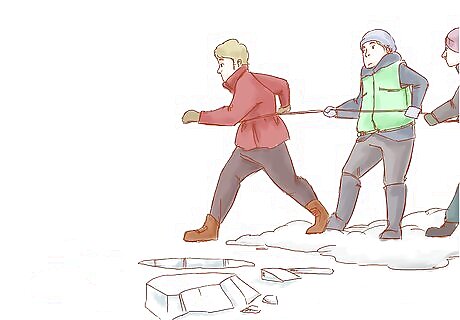
Test the thickness of the ice. If you have already made your observations and you still feel confident, you will need to back this up by checking the thickness of the ice. Test with at least one other person (the buddy system). Wear a flotation suit or device and use ropes that your buddy can pull on if something goes wrong. Only go on the ice if the edge of the water body is firm. If it is slushy or cracking, it is unlikely to be safe to proceed as shoreline ice is the weakest. Chip the ice with an axe or hatchet to create a small hole in the ice, or use an ice auger (a special tool which drills into the ice), for measuring the thickness through. Use a measuring device to determine the thickness. Learn the thickness safety margins of ice. There are recommended thickness measurements for the safety of ice that you will need to establish to for each activity being undertaken. (N.B. These are recommended, not guaranteed.) Ice begins to be "safe" at around 4 - 6 inches thickness. Do not even walk on ice 3" or less in thickness. However, even at a 9" - 10" thickness, there may be unforeseen hazards such as a flowing current underneath that is ceaselessly weakening the underside of the ice. In this instance, even the thickness is not a good indicator of safety, as the ice could collapse at any time. In general, the rules for ice thickness measurements are: 3" (7 cm) (new ice) - KEEP OFF 4" (10 cm) - suitable for ice fishing, cross-country skiing and walking (approx. 200 pounds) 5" (12 cm) - suitable for a single snowmobile or ATV (approx. 800 pounds) 8" - 12" (20 - 30 cm) - suitable for one car, group of people (approx. 1500 - 2000 pounds) 12" - 15" (30 - 38 cm) - suitable for a light pickup truck or a van These are commonly cited measurements.

Understand that ice strength is not the same everywhere, not even on the same body of water. The strength of ice is also affected by factors other than color and thickness. Also take into account: Location of the ice: is it on a pond, a lake, a stream or is there evident flowing water underneath it? Is there a flow into or out of the water body? This will give cause for concern. Constitution of the water: is it fresh water or saltwater? Sea ice tends to be weaker and needs greater thickness to support the same weight as fresh water. See the External Links below for more information on exact measurements. External temperature and season: temperature changes constantly. Beware microclimates in the local area. Mid-winter ice is bound to be a lot stronger than spring ice which is subject to rapid thawing and warming bouts of sunshine. Size and depth of the water body: larger bodies of water take longer to freeze than smaller ones. Presence of snow on the ice: snow can warm up the ice because it acts as an insulator; ice under snow is generally thinner and weaker than ice without snow. Weight on ice: what are you putting on the ice? Just you or you and a vehicle? There is a big difference in the weight distribution between a body and a snowmobile with said body on top.

Find alternatives if in any doubt. Skaters can always find a rink or a supervised lake area; snowmobilers and skiers can always stick to trails on land in place of crossing ice; walkers can keep off the ice and continue with their snowshoes along the trail. All out-goers should carry emergency supplies no matter how long they plan to be out nor where they plan to go.




















Comments
0 comment